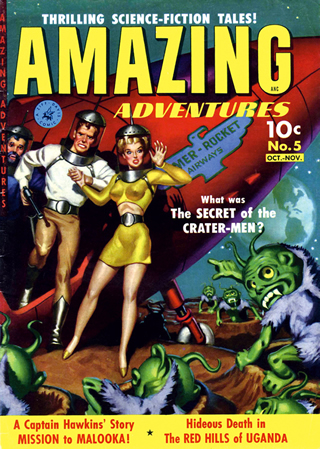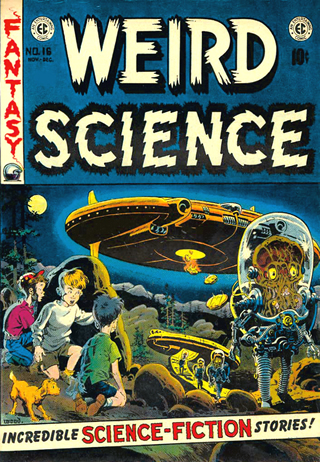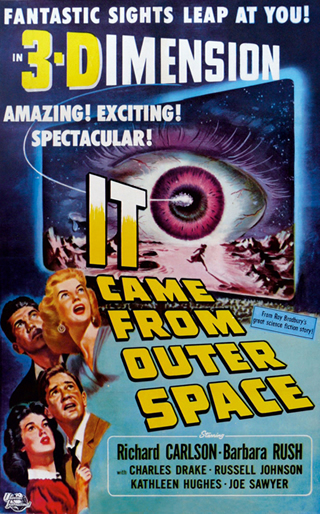It Came from Outer Space - Page 4
 |
 |
|
|
|
 |
|
|
 |
|
|
A defending military force, yet another theme of the Cold War, is convinced by Jimmy to help resist the alien invasion. The costuming and special effects are simplistic by today’s standards, but the story, with its trick ending, demands repeat viewings.
The theme of advanced scientific knowledge was played out in 1955's This Island Earth, as aliens in more recognizable form (humanoids with elevated foreheads) recruit Earth’s scientists to help rescue their distant planet, Metaluna. But in Invasion of the Body Snatchers, made the following year, the aliens replace humans altogether by inhabiting their bodies.
Such cautionary tales, says Joe Pilati, “were meant for the anti-communist crusades of the 1950s. And I grew up in that same mentality as everyone else in suburbia who was exposed to McCarthyism.” Even if we didn’t know or care about commies, it was the kind of thing that, after a weekend viewing, might move us to take a second look at that zombie-like school principal on Monday morning.
Then came that superlative sci-fi widescreen blockbuster, Forbidden Planet, from 1956, which rendered the threat Freudian and internal, in the form of self-created, supremely destructive ‘monsters of the Id.’ This unique premise was played out on a breathtaking distant planet, with the advantages of a great storyline, an engaging take-off on Shakespeare’s The Tempest and a better-than-B-movie script, by Cyril Hume, enhanced with humor, philosophy, and romance.
The engaging cast featured dramatic Canadian actor Walter Pidgeon, a young Leslie Nielsen, and sexy ingénue love interest Anne Francis.
Forbidden Planet also boasted mind-bending Space-Age effects, including the powerful but versatile and user-friendly Robby the Robot, the first-ever all-electronic score, and careful, propulsive direction by Fred M. Wilcox.
In the middle of it all was perhaps the closest thing to MCM architecture in any mid-century sci-fi film: the residence of Dr. Morbius and his beautiful daughter Altaira on the planet Altair IV, with its glassy facade and modular furnishings.
With something for everyone, Forbidden Planet was also arguably better suited for viewing by thoughtful adults than anything since The Day the Earth Stood Still. It was a great film for families to share on a Saturday night, and would be a hard act to follow during the rest of the decade.
In 1960, though, The Time Machine whisked viewers across 8,000 centuries with director George Pal’s thoughtful and entrancing take on a novel by H.G. Wells. Pal had produced sci-fi throughout the ‘50s, including a previous Wells adaptation, War of the Worlds, in 1953. This film managed to compact a history lesson, cautionary tale, romance, and monster show into a hundred eye-popping minutes.
The Time Machine’s ‘social science fiction’ was applied to a post-nuclear contemporary setting in The World, the Flesh, and the Devil and On the Beach, both made in 1959. In Walter Miller’s brilliant, sardonic 1960 novel A Canticle for Leibowitz, the world had been blown back to the Middle Ages by nuclear war, and was having to contend with mutants among the ruins. This sort of film and book placed blame, as had The Day the Earth Stood Still nearly a decade earlier, on society itself, with an implicit anti-war warning.




